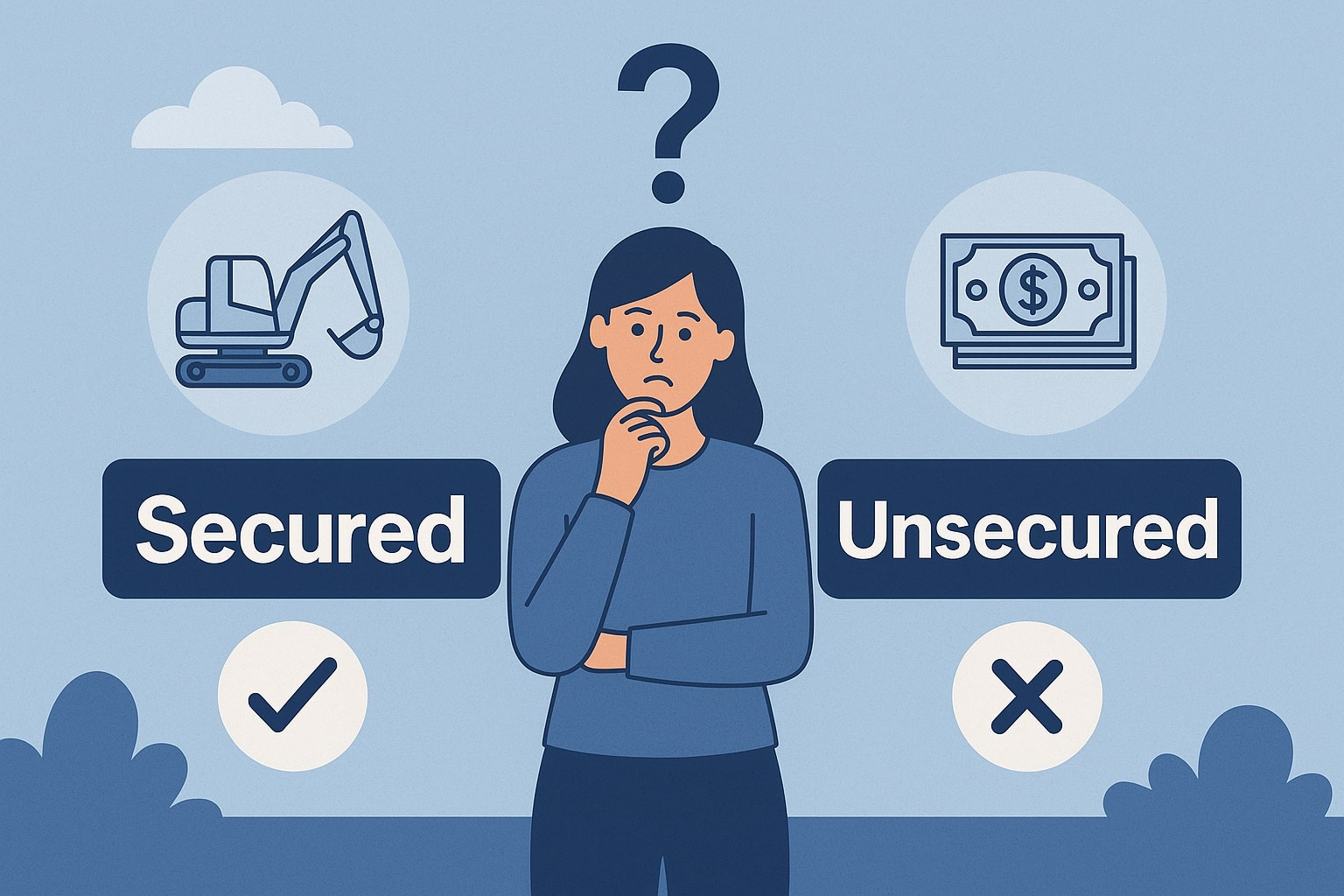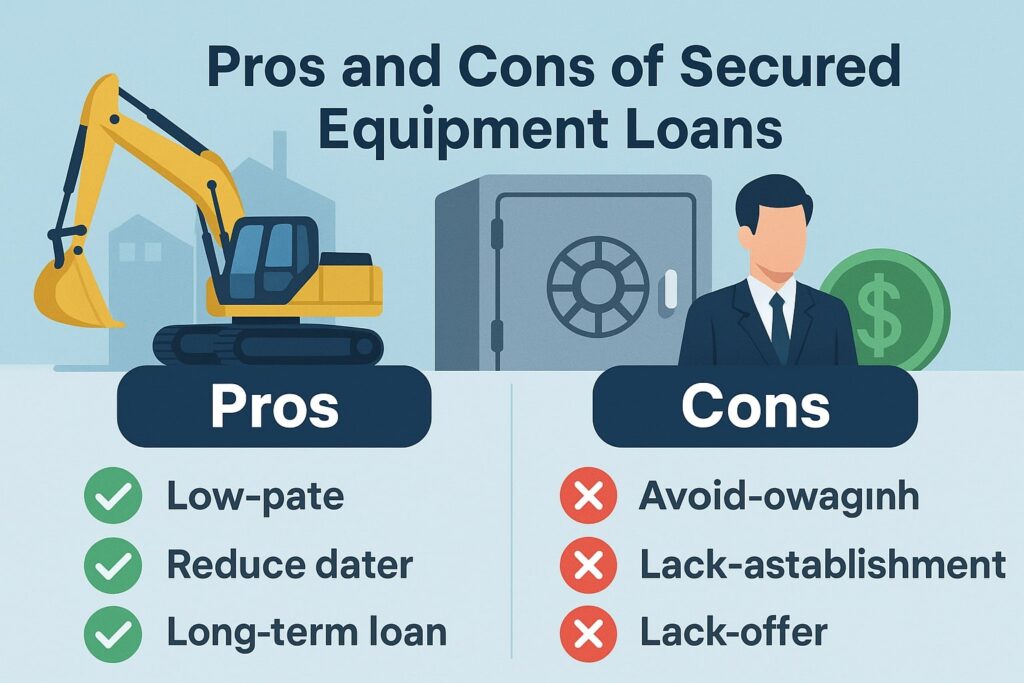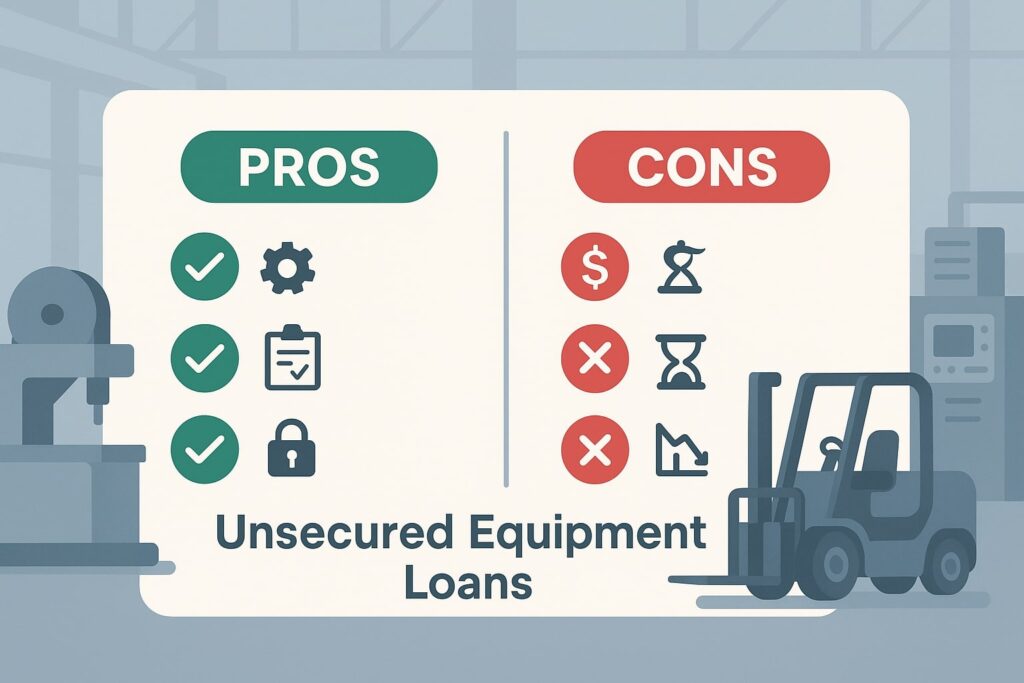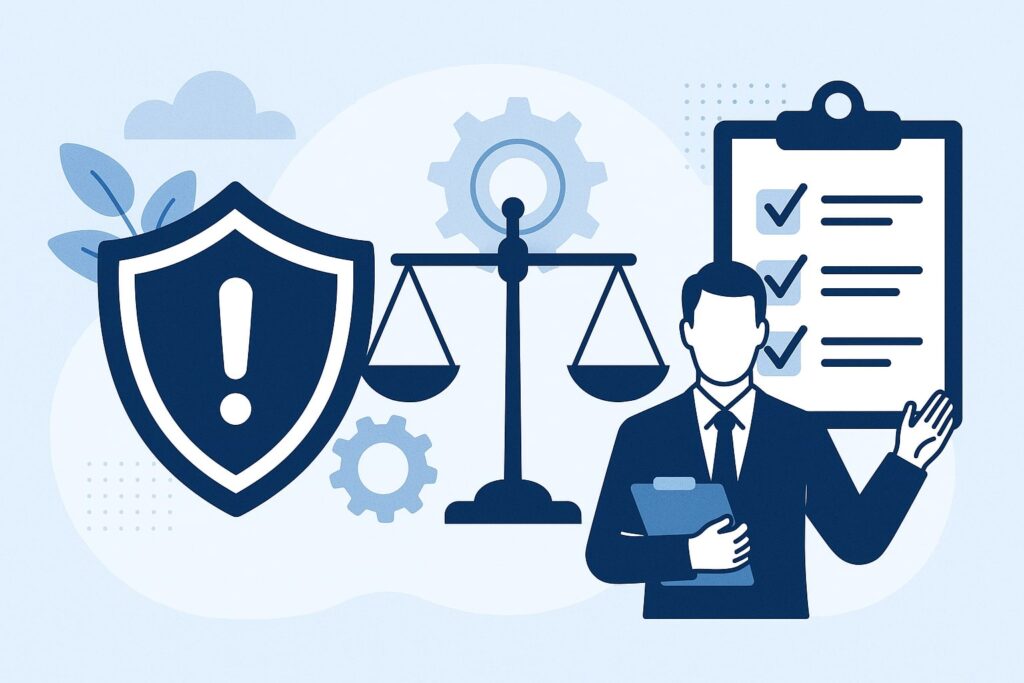
Secured vs Unsecured Equipment Loans: Pros and Cons
Choosing between secured vs unsecured equipment loans can shape your cash flow, tax strategy, and risk exposure for years. In the U.S., lenders price, structure, and underwrite these two options very differently, and the way you finance machinery, vehicles, POS systems, IT hardware, or medical devices can affect everything from insurance requirements to your business credit profile.
This guide breaks down how secured vs unsecured equipment loans work, why rates and terms diverge, what lenders look for, and how to decide which path is best for your company’s stage, margins, and growth plan. You’ll also see practical examples, negotiation tips, and a decision checklist you can use right away.
Throughout, we’ll stick to plain language and the U.S.-specific considerations like UCC-1 filings, blanket liens, SBA programs, and Section 179 deductions, so you can make a confident, compliant choice that supports your operations—not just this year, but across the full equipment lifecycle.
What Are Secured vs Unsecured Equipment Loans?
At a high level, secured equipment loans are backed by collateral—typically the equipment itself, sometimes plus additional assets—while unsecured equipment loans rely primarily on your business’s cash flow, credit strength, and personal guarantee without tying the lender’s claim to a specific asset.
In practical terms, secured financing gives the lender a first-position lien on the equipment. If you default, the lender can repossess and liquidate it to recover losses.
Because collateral reduces lender risk, secured equipment loans usually feature lower interest rates, longer terms, and higher maximum loan amounts. They often come with down payments, UCC-1 filings with your Secretary of State, and covenants like insurance requirements naming the lender as loss payee.
Unsecured equipment loans skip asset-specific collateral. You still may sign a personal guarantee or accept a general UCC filing, but there is no direct claim to the specific piece of equipment. Lenders compensate for the additional risk with higher APRs, shorter maturities, and lower approval ceilings.
The trade-off: speed and flexibility. For time-sensitive projects—like replacing a broken oven in a restaurant, adding a backup generator before storm season, or upgrading terminals for new payment security standards—an unsecured loan can fund quickly, sometimes in days.
When evaluating secured vs unsecured equipment loans, pay attention to:
(1) whether the equipment is easily resalable (construction, trucks, or yellow iron often are), (2) your time in business and DSCR (debt service coverage ratio), (3) your FICO and business credit file, and (4) whether a lien on the equipment might interfere with future financing.
The best choice lines up with your asset’s resale value, your margin profile, and your need for speed versus cost.
How Lenders Evaluate Each Option
Lenders look at secured vs unsecured equipment loans through distinct risk lenses. For secured loans, the equipment’s liquidation value is central. Underwriters check brand, model year, hours/mileage, maintenance records, warranty status, and secondary market demand.
They set advance rates—often 70–100% of purchase price for new equipment and less for used—based on loan-to-value (LTV). They’ll stress-test DSCR using realistic revenue assumptions and include insurance and maintenance in the affordability picture.
They also confirm that UCC-1 filings can be perfected in first position, and they may reject or reprice deals if a blanket lien or prior lender conflicts exist.
For unsecured loans, underwriters weigh cash flow first. They’ll analyze bank statements, seasonality, gross margins, and recurring obligations to forecast repayment capacity.
FICO scores, time-in-business, industry risk (e.g., restaurants vs. medical practices), and existing debt influence both approval and pricing. Because there’s no equipment-specific collateral, unsecured lenders rely more on personal guarantees and covenants that limit additional borrowing.
They may also shorten terms to reduce exposure—think 12–36 months instead of 48–84 months—and cap loan amounts below what a secured structure might allow.
In both categories, expect attention to: (1) down payment capacity, (2) tax returns or accountant-prepared financials, (3) insurance, and (4) compliance with state usury limits and disclosure rules.
If your equipment has high, stable resale value, secured structures shine. If timing is critical or you can’t grant a lien, unsecured can win—albeit at a higher cost.
Pros and Cons of Secured Equipment Loans

- Pros: The biggest advantage of secured financing is affordability. With collateral, lenders typically offer lower APRs, longer amortization (often 48–84 months for durable assets), and larger amounts.
The lower monthly payment can protect cash flow and help you meet DSCR targets while funding growth. Secured deals also tend to be friendlier to borrowers with shorter operating histories because the equipment helps mitigate risk.
Another plus: you may qualify for better terms on used equipment if it has a robust resale market (e.g., forklifts, skid steers, CNC machines). Many U.S. businesses also pair secured loans with Section 179 expensing and bonus depreciation, improving after-tax cost of ownership. - Cons: Collateral comes with strings. Expect UCC-1 filings, potential blanket liens, and restrictions that can complicate future borrowing. If you default, repossession is on the table.
You’ll likely need to maintain specific insurance, keep the asset in good repair, and get lender consent before major changes or asset sales. Appraisals, inspections, and documentation can slow funding. Some lenders charge origination fees, doc fees, and prepayment penalties to protect yield on low-rate loans.
If your equipment’s value depreciates quickly or is highly specialized, you may face a lower advance rate, a bigger down payment, or tighter covenants.
When comparing secured vs unsecured equipment loans, remember secured deals shine when you can leverage the asset’s value to obtain better pricing and longer repayment, but they reduce flexibility and increase consequences if things go sideways.
When Secured Loans Make the Most Sense
Choose secured equipment financing when the asset is mission-critical, durable, and liquid in the secondary market. Think long-haul tractors, excavators, foodservice ranges, imaging systems, chillers, and production lines.
If your business model depends on predictable, multi-year payback—say, a manufacturer adding a CNC router that cuts labor hours—secured loans align repayment with the asset’s revenue generation.
They’re also compelling when your margins are thin and every basis point of interest matters. Lower rates plus longer terms can keep utilization high without bleeding cash.
Secured structures also fit if you plan to use Section 179 or bonus depreciation to reduce taxable income in the purchase year. Because you’ll likely keep the asset for its full useful life, the interest savings can be substantial.
Another green flag: if your credit profile is average but your equipment is strong, collateral can pull you into approval.
Finally, secured loans make sense if you’re coordinating with other lenders; a clean, first-position purchase-money security interest (PMSI) avoids blanket-lien entanglements that unsecured lenders sometimes introduce.
In short, if you can tolerate a lien and want the best pricing, a secured path is often the smarter choice in the secured vs unsecured equipment loans debate.
Pros and Cons of Unsecured Equipment Loans

- Pros: Unsecured financing prioritizes speed and flexibility. There’s usually less documentation, no equipment appraisal, and fewer closing steps.
That can mean funding in days instead of weeks—perfect for replacing failed gear, capturing limited-time vendor discounts, or scaling quickly to meet seasonal demand.
You avoid a specific lien on the asset, which can preserve maneuverability for future credit lines or asset-based facilities. For smaller-ticket purchases (like POS terminals, laptops, or small kitchen equipment), unsecured structures can be frictionless and keep operations moving.
Cons: The trade-off is cost. APRs are often higher, terms shorter, and monthly payments steeper. Origination fees may apply, and some providers quote factor rates that can obscure true APR—so always normalize costs.
Without equipment collateral, lenders rely heavily on personal guarantees and your cash flow. If your revenues dip, a short-term unsecured schedule can pressure liquidity fast.
Some providers include aggressive daily or weekly repayments; while those can be fine for very short projects, they can strain working capital. Also, unsecured lenders may file a general UCC notice or include covenants that limit new debt, even if they don’t claim your equipment specifically.
When you weigh secured vs unsecured equipment loans, unsecured can be the right tool for urgent needs or small-dollar upgrades—but you’ll pay for the convenience. Make sure the faster timeline and lien flexibility truly outweigh the higher all-in cost.
When Unsecured Loans Are the Better Fit
Pick unsecured financing when time-to-funding beats rate. If your walk-in cooler died on Friday and you need a replacement running by Wednesday, a simple unsecured loan could save inventory and revenue, even at a higher APR.
Unsecured is also useful when vendors offer steep early-pay discounts; if the discount outstrips the financing premium, you still come out ahead. Another case: you plan to refinance soon—perhaps into an SBA 7(a) or 504 package, or into a revolving line once financials improve. Unsecured serves as a bridge, letting you avoid locking the asset under a long lien during interim fixes.
Unsecured can also help businesses concerned about covenant complexity. While you may still sign a PG, you avoid asset-specific collateral and appraisals.
For purchases under, say, $50,000–$150,000, the ease of underwriting can be compelling—especially for service businesses buying tools, tech, or light vehicles. Just ensure the shorter term won’t crimp cash flow.
Model best and worst-case scenarios, including seasonality. In the secured vs unsecured equipment loans comparison, unsecured wins when speed, simplicity, and flexibility clearly create more value than the interest you’ll pay.
Cost, Rates, and Total Cost of Ownership (TCO)
Your real goal isn’t just “lowest rate”—it’s the lowest total cost for the utility you get. In secured vs unsecured equipment loans, the secured option generally carries lower APR and longer terms, producing smaller payments and lower lifetime interest, especially for assets with long useful lives.
But unsecured’s speed can unlock vendor rebates, avoid downtime, and capture revenue that more than offsets the premium. That’s TCO thinking.
Calculate:
(1) principal + all fees + interest over the full term,
(2) any prepayment penalties,
(3) insurance costs mandated by the lender,
(4) tax benefits (Section 179, bonus depreciation, MACRS), and (5) expected resale value. Compare that to operational benefits: higher throughput, reduced scrap, energy savings, better uptime, or new revenue streams.
Next, align repayment frequency with cash inflows—monthly for steady businesses, potentially weekly for high-velocity retail—so DSCR stays healthy.
For apples-to-apples comparisons, convert factor rates to APR and compute IRR of cash flows. Ask lenders for full amortization schedules and prepayment clauses in writing. On secured vs unsecured equipment loans, subtle differences (like a 1% origination fee or a 6-month shorter term) can add thousands to TCO.
Always model scenarios before you sign, and remember that the “cheapest” loan that arrives two weeks too late can be the most expensive decision you make.
Example Repayment Scenarios
Scenario A (Secured): A $250,000 new CNC financed over 72 months at 8.5% APR with 10% down. Monthly payment lands near the mid-$3,000s, backed by a first-position lien on the machine. Insurance adds a modest monthly cost, but Section 179 enables significant first-year expensing (consult your tax advisor).
Over the term, total interest might be tens of thousands—but the machine boosts throughput by 18%, paying for itself in year two. In the secured vs unsecured equipment loans comparison, the secured route pairs long asset life with long amortization, keeping DSCR healthy.
Scenario B (Unsecured): A restaurant needs a $45,000 replacement range and hood in five days. They secure an unsecured 24-month loan at a higher APR with weekly payments. Total interest is materially higher than Scenario A, but downtime avoided saves $6,000 per week in lost revenue and food spoilage.
The ROI remains positive even with the premium. Later, the owner refinances into a lower-rate term loan after peak season. Here, the “unsecured now, refinance later” plan wins the secured vs unsecured equipment loans debate because timing is the decisive variable.
Key takeaway: model both the cash cost and the opportunity cost. Where speed prevents lost sales or captures discounts, unsecured can outperform on TCO despite the rate.
Application, Documentation, and Underwriting in the U.S.
Expect a different paperwork rhythm across secured vs unsecured equipment loans. For secured, gather vendor quotes, serial numbers/VINs, spec sheets, and (for used) maintenance logs. Provide business tax returns (typically 2 years), year-to-date financials, bank statements (3–6 months), AR/AP aging, debt schedules, and proof of insurance.
Some lenders require appraisals or site inspections. You’ll sign documents authorizing a UCC-1 filing and, often, a personal guarantee. Timeline: one to three weeks, depending on complexity.
Unsecured applications are lighter: government ID, bank statements, a recent P&L, perhaps one year of returns, and a basic equipment invoice. Funding can be much faster—often a few business days—though limits and terms are tighter.
Regardless of type, strengthen your file with clean bank activity (avoid NSFs), stable average daily balances, and a simple narrative explaining ROI, installation plan, and contingency coverage. Underwriters love clarity.
For both secured vs unsecured equipment loans, mind compliance: truth-in-lending style disclosures where applicable at the state level, usury limits, and clear APR communication.
If you’re offered a merchant cash advance or factor rate product, ask for the equivalent APR and full fee schedule. Keep a document vault: EIN letter, operating agreement/bylaws, business license, lease, W-9, and insurance COI. The more organized you are, the more negotiating power you retain.
SBA and Government-Backed Options
SBA programs can tilt the secured vs unsecured equipment loans calculus. The SBA 7(a) program offers broad use of proceeds, including equipment, often with competitive rates and longer terms than conventional unsecured options.
The SBA 504 program is tailor-made for fixed assets—equipment and real estate—pairing a bank first lien with a Certified Development Company (CDC) second. For heavy equipment with long life, 504 can deliver excellent pricing and extended repayment.
These are still “secured” loans in most cases, with collateral and guarantees, but the SBA guarantee reduces lender risk, potentially helping newer businesses or borrowers with thinner collateral. Expect more paperwork and a longer timeline—several weeks to a couple of months.
If your purchase is planned and material to your strategy, SBA can be worth the wait. Align with your CPA on Section 179 and bonus depreciation; the combination of low-rate SBA financing and tax acceleration can meaningfully reduce TCO.
For smaller, urgent needs, SBA is usually too slow, and an unsecured loan may bridge the gap until a refinance into 7(a) or 504 is possible. In the secured vs unsecured equipment loans decision, SBA often represents “secured, but cheaper,” traded against speed.
Risk Management, Legal, and Compliance Considerations

Risk in secured vs unsecured equipment loans shows up differently. In secured deals, the lender’s first-position lien and right to repossess sharpen default consequences.
Confirm whether the lender uses a blanket lien or a PMSI only on the purchased asset; the former can limit future borrowing and complicate working-capital lines.
Review cross-default clauses (a default on one facility triggering default on others) and any financial covenants (minimum DSCR, liquidity, or leverage). Verify insurance requirements—property, inland marine, auto (for titled vehicles), and lender loss-payee endorsements.
For unsecured loans, watch repayment frequencies, confession-of-judgment clauses (where applicable), and broad PG language.
Ensure you understand state-level disclosure rules (e.g., in California, New York, and other states with commercial financing disclosures) and that APR and prepayment terms are explicit. If you see a factor rate, request an APR conversion and amortization schedule. Confirm whether the lender will file a general UCC and if it conflicts with existing or future lines.
In both secured vs unsecured equipment loans, keep a compliance checklist:
(1) confirm lien position,
(2) verify filing states (multi-state operations may require multiple UCC filings),
(3) map covenant calendars,
(4) maintain records for IRS audits of Section 179 and depreciation, and
(5) document installation, testing, and acceptance to align with vendor warranties.
A clean paper trail reduces disputes and speeds approvals, modifications, or future refinances.
How to Negotiate and Avoid Pitfalls
Negotiation is leverage plus preparation. In secured vs unsecured equipment loans, gather at least two competing quotes. Ask each lender to price the same facts: loan amount, term, payment frequency, closing fees, prepayment language, and any rate escalators.
Use a comparison sheet to normalize APRs. Request PMSI-only language instead of a blanket lien where possible, and cap or eliminate prepayment penalties after a modest lockout. If the lender requires a PG, push for burn-off provisions once DSCR and payment history benchmarks are met.
Ask vendors for extended warranties, installation credits, or early-pay discounts—and capture that value in your TCO model. For unsecured providers that quote factor rates, insist on APR transparency and an amortization schedule.
If daily or weekly payments are proposed, evaluate a monthly option and model cash-flow seasonality. Avoid stacking multiple short-term facilities unless you’ve modeled the combined DSCR and covenant interactions.
Lastly, review all documents with counsel, especially lien language, cross-defaults, choice of law, and dispute resolution. In the secured vs unsecured equipment loans context, most pitfalls arise from hidden fees, confusing repayment structures, and lien surprises—not the headline rate.
Decision Framework and Checklist
When deciding between secured vs unsecured equipment loans, anchor on three pillars: Asset, Cash Flow, and Clock.
- Asset: Is the equipment durable, mission-critical, and liquid on resale? If yes, secured usually wins with lower APR and longer terms. If the asset is specialized, perishable in value, or low-ticket, unsecured can avoid over-collateralizing.
- Cash Flow: How sensitive is your DSCR to payment size and frequency? Secured deals reduce monthly burden; unsecured may compress payments into 12–36 months. Stress-test slow months and realistic downtime.
- Clock: How fast do you need funding? If an extra week costs you revenue or vendor discounts, speed might trump rate—favor unsecured or vendor financing. If you can wait, secured or SBA can save materially.
Checklist: (1) gather two quotes for each path, (2) request APR, fees, and prepayment terms in writing, (3) confirm UCC type (blanket vs PMSI), (4) align term with useful life, (5) verify insurance requirements, (6) compute Section 179 and bonus depreciation impacts, (7) map refinance options (e.g., bridge unsecured → SBA), (8) confirm covenants and cross-defaults, and (9) document ROI assumptions.
Apply this framework, and your secured vs unsecured equipment loans choice will reflect economics—not guesswork.
Side-by-Side Comparison (Narrative)
- Cost & Term: Secured loans: lower APR, longer terms (often 48–84 months), smaller payments. Unsecured: higher APR, shorter terms (12–36 months), bigger payments. Over a long horizon, secured usually delivers a lower TCO if timing isn’t critical.
- Collateral & Flexibility: Secured uses asset-specific collateral; repossession risk exists but pricing is better. Unsecured avoids tying up the equipment specifically, which can simplify future financing—but lenders may still file general UCCs or rely on PGs.
- Speed & Documentation: Secured: heavier underwriting (appraisals, inspections), slower close. Unsecured: lighter docs, faster funding. For emergency replacement or discount windows, unsecured can be the right tool.
- Use Cases: Secured fits big-ticket, durable assets with clear ROI and resale value. Unsecured fits small-to-mid tickets, urgent timelines, or bridge situations. In the secured vs unsecured equipment loans decision, these distinctions shape both cost and operational agility.
FAQs
Q1: Will either option affect my personal credit?
Answer: Possibly. Many lenders require a personal guarantee for both secured vs unsecured equipment loans—especially for newer businesses. Some pull a hard credit inquiry, which can temporarily impact your score.
However, on-time payments typically build your business credit file more than your personal score. Ask whether the lender reports to business credit bureaus and if a PG can burn off after a strong payment history.
Q2: Can I deduct payments or depreciate the equipment?
Answer: Interest expense on business loans is generally deductible. The principal is not. For the equipment, U.S. businesses often use Section 179 expense and bonus depreciation (subject to annual limits and phase-downs) to accelerate tax benefits.
Consult your CPA to optimize tax treatment for either secured vs unsecured equipment loans, and ensure documentation matches IRS requirements.
Q3: What’s the difference between APR and a factor rate?
Answer: APR annualizes all costs (interest plus fees) over the term. Factor rates quote a fixed cost multiplier on principal (e.g., 1.35×) without time value. Always convert factor quotes to APR for apples-to-apples comparisons in secured vs unsecured equipment loans decisions, and request an amortization schedule.
Q4: Do unsecured lenders still file UCCs?
Answer: Sometimes. Even without asset-specific collateral, lenders may file a general UCC notice. Confirm whether it’s a blanket lien and how it affects future borrowing. In many secured vs unsecured equipment loans scenarios, negotiating a PMSI for secured or limiting a general UCC for unsecured preserves flexibility.
Q5: How big a down payment should I expect?
Answer: Secured equipment loans often ask for 0–20% down, depending on asset age and LTV. Unsecured financing may require no down payment but compensates with higher APR and shorter terms. Evaluate down payment against TCO and your cash runway, not just approval odds.
Q6: Can I refinance from unsecured to secured later?
Answer: Yes. Many firms bridge with an unsecured loan for speed, then refinance into a secured or SBA facility once the equipment is installed and generating cash. Model prepayment penalties and closing costs before committing. This can balance the secured vs unsecured equipment loans trade-off: speed now, savings later.
Q7: What if my state has special disclosure laws?
Answer: Several states require commercial financing disclosures (e.g., APR equivalents, total cost). Ensure your lender complies and that you receive clear documents. This transparency helps you compare secured vs unsecured equipment loans fairly across providers.
Conclusion
There’s no one-size-fits-all winner in the secured vs unsecured equipment loans debate. Secured financing usually delivers lower APRs, longer terms, and bigger approvals, making it ideal for durable, high-value assets where you can wait for underwriting and accept a lien.
Unsecured financing trades speed and simplicity for higher cost, fitting urgent replacements, smaller-ticket upgrades, and bridge strategies that keep operations humming. The best path depends on your asset’s resale value, your DSCR under realistic scenarios, and how much timing matters to your revenue and vendor discounts.
Use the framework here: quantify TCO, normalize APRs, confirm UCC and PG details, align terms with useful life, and map a refinance plan if needed. Combine that with U.S.-specific tax planning—Section 179 and bonus depreciation—to sharpen after-tax ROI.
Make your choice deliberately, document it well, and you’ll finance equipment in a way that protects cash flow, supports growth, and keeps your next round of financing options open.